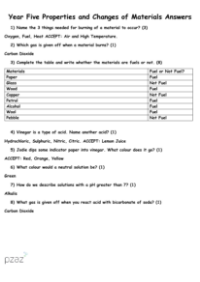Properties and Changes of Materials - Assessment

Science Resource Description
The Year Five assessment on Properties and Changes of Materials tests students' understanding of various scientific concepts related to materials and their interactions. The assessment begins by asking students to name the three elements necessary for the combustion of a material, followed by identifying the gas released during burning. Students then categorize a list of materials such as paper, glass, and petrol, as fuels or non-fuels. To assess their knowledge of acids, they are asked to name another acid besides vinegar and predict the colour change of indicator paper when dipped into vinegar. The test also includes questions about the pH scale, such as the colour indicating a neutral solution and how to describe solutions with a pH greater than 7.
Further questions explore the students' understanding of solubility, asking them to identify the property of substances that dissolve in water and the general terms for such substances and the liquid they dissolve in. The assessment includes a practical component where students must decide whether certain substances like sand, sugar, and oil are soluble in water. Additionally, they are expected to know the result of dissolving salt in water and the methods for separating mixtures such as saltwater and sand-water mixtures. The test also covers the hardness of materials, asking students to rank the hardness based on an experiment and classify materials as transparent, translucent, or opaque, while considering which would cast the darkest shadow. Finally, the assessment delves into thermal properties, questioning the boiling point of water, the term for materials that allow heat to travel well, and why certain materials are used for specific purposes, such as mug handles. It concludes with questions on electrical conductivity, asking students to classify materials as conductors or insulators and explain the properties that make plastic suitable for electrical wiring.







